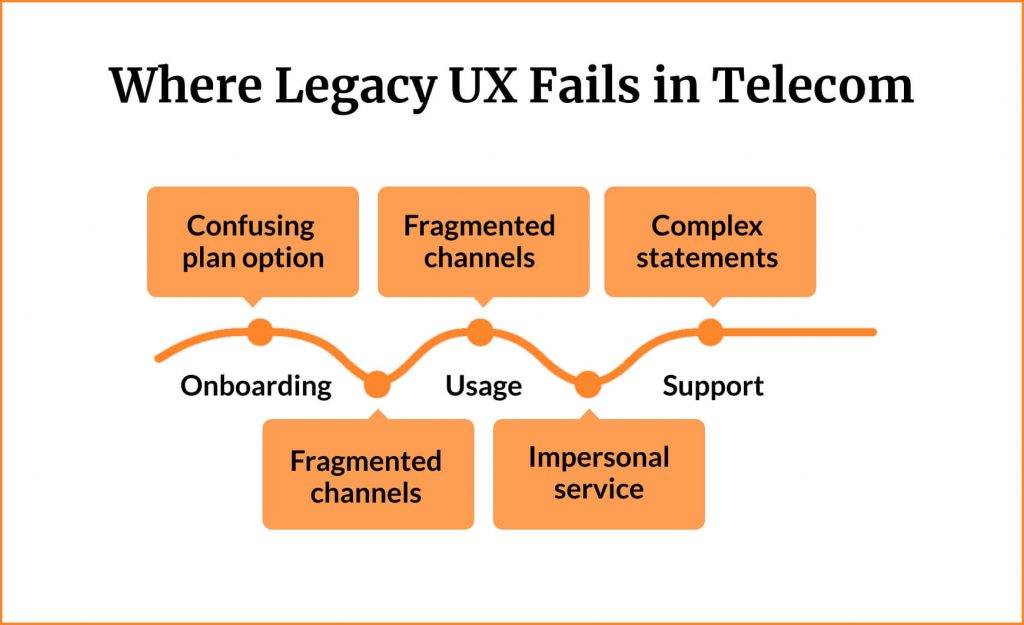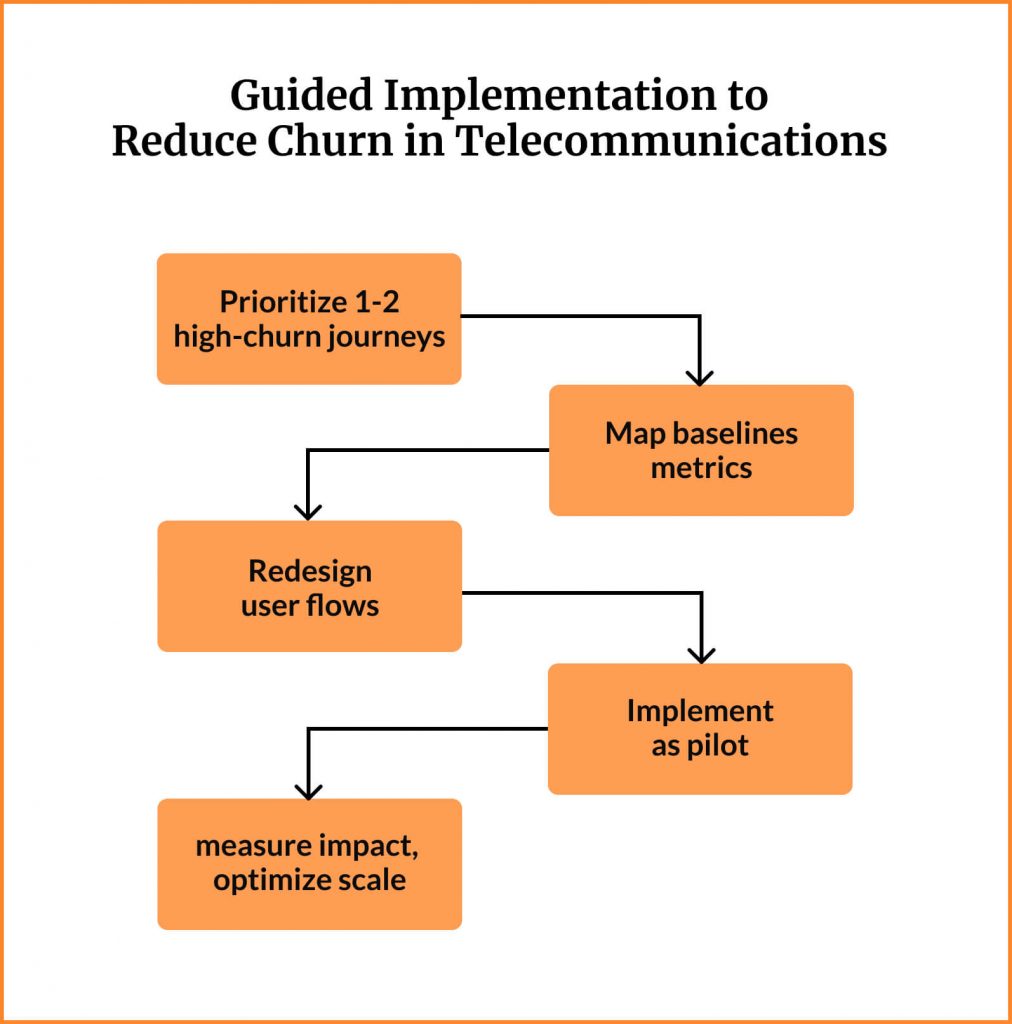
Jump To Section
In an industry where switching providers is as easy as clicking a button, telecom companies face some of the most intense customer churn pressures in the market. While estimates vary, most place the average annual churn rate for telecoms at between 15% and 25%, depending on the service and region.
Yet it’s not just the ease of leaving that’s the problem—it’s the experience of staying.
Telecom customers are increasingly frustrated by fragmented digital journeys, unclear billing, and impersonal support. As a result, they often switch providers not because they find something better, but because the friction became too much to ignore.
In this article, we will explore why UX is no longer a “nice to have,” but a core business strategy and how telecoms can reduce churn through intelligent, empathetic, and measurable design.
The Legacy Problem: Where Telecom UX Fails

Despite massive investment in apps, automation, and digital portals, many telecoms still fall short in the experience department. The root cause is often legacy thinking, where technology investments focus on backend efficiency rather than customer ease.
To address this, telecoms must adopt a customer centric approach, aligning operations and technology with customer needs to enhance satisfaction and loyalty.
Confusing plan options are a common offender: multiple variations, fine print disclaimers, and opaque bundling strategies make it hard for customers to compare or feel confident in their choices. When users try to upgrade or modify plans, they are often bounced across touchpoints, with apps showing one price and call center reps quoting another.
Support is another area where telecoms lose loyalty. Many support queues leave customers waiting 10+ minutes before reaching an agent. According to Forrester, 60% of consumers have placed quick resolution times as a critical part of the experience with a company. This emphasizes not speed, but clarity and effectiveness in support design. Addressing customer complaints promptly and providing exemplary customer service is essential to maintaining trust and satisfaction.
Channel fragmentation only compounds the issue. Many telecoms operate with siloed systems for apps, web, IVR, and in-store experiences. This leads to inconsistent branding, different user flows, and disconnected customer records.
The lack of a seamless and organized experience leads to customer frustration and dissatisfaction. Customers end up re-explaining their issue multiple times—and frustration builds. Establishing clear communication channels across all platforms is crucial to improving the user experience and ensuring effective interactions.
According to PwC’s 2022 U.S. consumer insights, 32% of customers say they will stop doing business with a company after one bad experience, and 55% will leave after several.
Meanwhile, McKinsey’s telecom benchmarks show that onboarding and billing issues are the top two drivers of first-year churn. Optimizing billing processes and improving overall service efficiency are critical steps to reduce churn and provide a more reliable user experience.
It’s clear: poorly designed user journeys are not just an inconvenience—it’s a revenue leak.
Strategic Redesign: Telecom UX That Moves the Needle
To reverse churn trends, telecom companies must design with intention. That means moving beyond UI polish and investing in foundational experience strategy.
Optimizing the user experience requires targeted experience strategies and refining user experience management to deliver more personalized, seamless, and responsive service. Leveraging technology solutions and focusing on operational efficiency are also essential parts of a strategic redesign. Here’s how:
Safeguarding Data Trust
In today’s telecommunications industry, safeguarding customer data is more than a compliance requirement—it’s a cornerstone of customer trust and a positive customer experience.
As customer expectations rise, telecom companies must prioritize robust data security to protect sensitive information from breaches and unauthorized access. Implementing advanced security measures, such as end-to-end encryption and multi-layered firewalls, helps telecom providers defend against evolving cyber threats.
Equally important is transparency. Customers want to know how their data is collected, stored, and used.
By clearly communicating data handling practices and offering accessible privacy controls, telecom providers can foster trust and demonstrate a commitment to customer satisfaction. Proactive communication about security updates and privacy policies reassures customers that their information is in safe hands.
Continuous monitoring and regular updates to security protocols ensure that telecom companies stay ahead of emerging risks. This vigilant approach not only meets customer expectations but also enhances the overall reputation of the telecom provider. In a competitive market, a strong data protection strategy is essential for delivering a positive customer experience and maintaining long-term customer relationships.
Leveraging Feedback Loops
Customer feedback is a goldmine for telecom companies aiming to exceed customer expectations and deliver exceptional user experiences. By actively collecting and analyzing customer feedback from every interaction—whether through surveys, support calls, or digital channels—telecom providers gain valuable insights into customer behavior and preferences.
Leveraging data analytics, telecom operators can identify patterns in customer interactions, pinpoint pain points, and uncover opportunities to tailor services for different customer segments. This data-driven approach to user experience management enables telecom companies to refine their offerings, introduce innovative solutions, and personalize interactions at every stage of the customer journey.
Fostering a customer-centric culture is key. Encouraging open communication and making it easy for customers to share their opinions empowers telecom providers to stay aligned with evolving customer expectations.
By acting on feedback and demonstrating responsiveness, telecom companies not only improve customer satisfaction but also build lasting customer loyalty and retention.
Ultimately, listening and learning from customers drives continuous improvement and keeps telecom operators ahead in a rapidly changing market. Get more personalization strategies to enhance the customer experience here.
Continuous Monitoring for Proactive Experience Management
To deliver exceptional customer experiences and maintain a competitive edge, telecom companies must embrace continuous monitoring as a core component of their experience strategy.
By systematically tracking customer interactions, service metrics, and industry trends, telecom providers can proactively identify issues and address them before they impact customer satisfaction.
Emerging technologies, such as artificial intelligence and machine learning, empower telecom operators to analyze vast amounts of customer data in real time. These tools can predict potential churn, highlight service delivery gaps, and recommend targeted interventions to optimize the customer journey. Continuous monitoring also enables telecom companies to adapt quickly to changing customer expectations and market dynamics. For an in-depth discussion on overcoming AI adoption challenges, watch this webinar on Enterprise-ready AI Models.
Regular assessment of customer feedback and service performance ensures that telecom providers are always refining their customer experience management strategies. By prioritizing ongoing support and improvement, telecom companies can deliver seamless and organized experiences that drive customer loyalty, enhance overall customer satisfaction, and set new standards for service excellence in the telecommunications industry.
Design Thinking for Full Journeys to Meet Customer Expectations
Design thinking is not just about screens—it’s about systems. Leading telecoms use it to deeply understand how customers move across onboarding, usage, upgrades, support, and renewal. By mapping customer journeys, they identify pain points and opportunities for tailoring services to individual needs. They map user flows, conduct service blueprinting, and identify high-friction moments.
One example: a U.S. regional telecom discovered that over 40% of its support calls originated from confusion during onboarding. A redesign of the welcome email, activation instructions, and in-app guidance led to a 30% drop in new user support requests.
Enabling Seamless Self-Service
When done right, self-service doesn’t just reduce costs—it builds trust. Offering a variety of self service options, including self service kiosks and self service portals, empowers customers to manage their telecom services efficiently and independently. Telecoms should audit their digital tools for completion rates and drop-offs. Are customers able to activate a new SIM, manage roaming, or pay bills without calling in? Are error messages contextual and helpful?
Digital tools should enable user friendly solutions that allow customers to manage account inquiries and other tasks independently. Embedding live chat during high-abandonment moments, personalizing usage dashboards, and simplifying workflows are all proven tactics. And don’t underestimate the power of proactive nudges: letting customers know when they’re close to data limits or eligible for loyalty offers improves perceived value.
Personalizing usage dashboards also allows telecoms to deliver personalized services and foster personalized interactions, which can significantly enhance customer satisfaction.
Finally, it is crucial to provide accessible and transparent avenues for customers to interact with telecom services, ensuring a seamless and customer-centric experience. Find a more detailed guide on breaking Self-Service barriers for telecom operators here.
Omnichannel Continuity and CRM Intelligence
True omnichannel experience isn’t about duplicating content across platforms—it’s about continuity. To ensure seamless interactions and deliver seamless user experiences across all channels, every touchpoint must be connected and consistent. If a customer begins a cancellation in-app, a retention agent should see that intent before the call even begins.
This requires CRM integration and shared design systems. It also requires rethinking incentives: many telcos still measure call centers by handle time rather than resolution quality. Analyzing customer interactions through integrated CRM systems helps improve service quality and proactively address customer needs. Experience-led organizations align internal KPIs with customer outcomes.
By adopting these approaches, telecommunications providers can better meet customer needs and expectations, building trust and satisfaction through proactive engagement.
Implementation in Action: Pilot Framework and Case Study

Improving telecom user experience requires more than broad ambitions—it demands structured execution.
Effective user experience management is critical in the telecom industry, where complex challenges and high customer expectations require targeted strategies and continuous improvement. These practices are essential for improving the user experience in telecom, boosting customer loyalty, and staying competitive in the telecom sector.
This practical step-by-step framework will help telecom team rethink and redesign high-friction experiences to reverse the customer churn:
1. Identify High-Churn Touchpoints
Start by isolating 1–2 journeys that consistently generate complaints, confusion, or support tickets. Common areas include SIM activation, roaming setup, billing disputes, and digital support escalation.
Use internal data to prioritize:
- Call center transcripts
- Support ticket categories
- Digital funnel drop-off analytics
- Post-interaction CSAT/NPS scores
- Tracking customer satisfaction scores to identify pain points and areas where the customer experience can be improved
2. Map the Current Journey
Visualize how customers navigate the journey today. Include:
- Each step they take (clicks, logins, waits)
- Systems and channels involved (app, IVR, agent, web)
- Where transitions break or context is lost
Understanding every customer interaction is crucial to identify friction points and ensure seamless communication throughout the journey.
Tools like service blueprints and journey maps help expose friction that may not be visible in raw data.
3. Define Success Metrics for Customer Satisfaction
Set clear, quantifiable goals before launching any redesign. Examples:
- Improve CSAT from 68 to 80 on the selected flow
- Reduce support escalations by 20% for that issue category
- Decrease journey completion time by 30%
Include targets for increased customer satisfaction and building brand loyalty as part of your success metrics, as these are critical outcomes of effective customer experience strategies in the telecom industry.
Ensure all teams agree on how success will be measured.
4. Prototype and Test
Design and test low-risk interventions:
- New page flows or UI elements
- Script improvements or IVR branching logic
- Proactive notifications or app nudges
- Pilot new technology solutions such as queue management systems or self-service portals to streamline the user experience
Use A/B testing or release changes to a limited geographic or user segment. Collect feedback quickly and iterate.
5. Operationalize and Scale
If metrics improve, embed the redesign into your customer experience operations:
- Update design systems and CRM workflows
- Train agents or retail staff accordingly
- Measure long-term performance and revisit regularly
Scaling successful pilots not only standardizes best practices but also drives operational efficiency and service efficiency by streamlining processes, reducing wait times, and improving overall service quality.
Scaling doesn’t mean replicating everywhere—it means applying the same disciplined process journey by journey.
Case in point: How a US-based telecom company reversed customer churn
A mid-sized telecom operator in the US saw a sharp churn spike among customers aged 18 to 35. As a telecom company, they recognized the urgent need to improve customer retention to maintain profitability and reduce churn.
User interviews revealed frustration with lost chat history, unclear troubleshooting steps, and the inability to resolve SIM issues digitally. Poor support experiences negatively impacted telco customers and existing customers, leading to dissatisfaction and increased risk of churn. Customers reported starting with the app, then being redirected to call centers without any handoff.
Solution
A persistent ticket system was required, which would be visible across app and agent CRM, in addition to redesigned FAQs into guided diagnostic tools (with embedded video tutorials). To further enhance user experiences, self service options such as digital portals and automation technologies were introduced, enabling customers to independently manage their telecom services efficiently and conveniently.
It was also necessary to implement real-time sentiment capture at key journey points.
Results
Following support resolution, the telecom operator achieved a 25% reduction in churn, a 35% decrease in escalated support cases, and a 15-point lift in customer satisfaction (CSAT), validating the importance of not just designing better interfaces but better handoffs, better tools, and better feedback loops. These improvements significantly boosted satisfaction and demonstrated the power of proactive, iterative experience strategies.
Final Takeaway: Why Designing a Strong User Experience Is the Key to Telecom Loyalty
Designing for telecom UX is no longer an aesthetic choice. It’s a competitive strategy. In a category where products are commoditized and pricing races to the bottom, experience is the differentiator. Delivering seamless and exceptional customer experience, including providing seamless connectivity, is key to building loyalty and setting your brand apart.
Leading telecom companies that invest in strategic UX will:
- See measurable churn reductions
- Improve loyalty and upsell success
- Decrease support overhead
- Stand out in a saturated market
Customers don’t stay for your bandwidth. They stay because it’s easy, because they feel supported, and because they’re not wasting time jumping through digital hoops.
FAQs
What is telecom user experience?
Telecom user experience refers to how users perceive and interact with a telecom brand across all digital and physical touchpoints—including apps, support, websites, and stores. The quality of telecom services and the implementation of effective user experience strategies play a crucial role in shaping overall customer perception and satisfaction.
What causes high telecom churn?
The main reasons include poor onboarding, fragmented support, confusing plan options, and inconsistent experiences across platforms. Unresolved customer complaints and the absence of effective customer support hotlines also contribute significantly to high churn, as customers seek providers with better communication and support. When friction outweighs convenience, users switch.
How does UX design reduce churn?
Design thinking identifies friction points and resolves them with intuitive workflows, better digital tools, and consistent service across channels. Additionally, analyzing customer interactions and implementing continuous monitoring and improvement are essential to ensure ongoing user experience success, allowing telecom companies to proactively address customer needs and enhance service quality.
What metrics show telecom success of the user experience?
Key indicators include CSAT, NPS, churn rate, task success rate, and support ticket volume—tracked before and after each redesign initiative. Tracking customer satisfaction scores and refining user experience management based on these metrics helps telecom companies enhance service quality, personalize experiences, and drive continuous improvement.
Can UX investment show ROI?
Yes. Improved UX leads to reduced operational costs, stronger retention, and more revenue through loyalty and upselling—resulting in clear, measurable ROI. Enhanced operational efficiency and service efficiency, achieved through technology-driven solutions and process improvements, further contribute to measurable ROI by streamlining operations and improving service quality.



